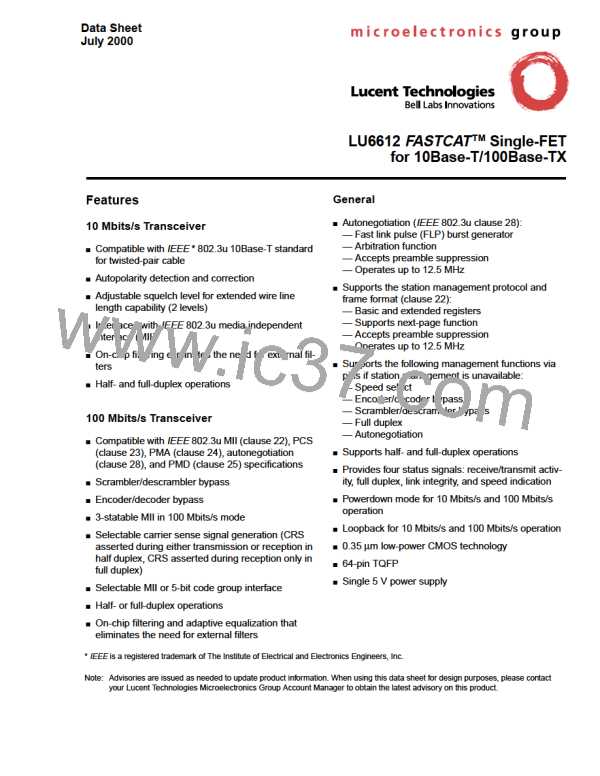LU6612
Data Sheet
July 2000
FASTCAT Single-FET for 10Base-T/100Base-TX
MII Station Management (continued)
Table 10. MR1—Status Register Bit Descriptions
Bit1
Type2
Description
1.15 (T4ABLE)
R
100Base-T4 Ability. This bit will always be a 0.
0: Not able
1: Able
1.14 (TXFULDUP)
1.13 (TXHAFDUP)
1.12 (ENFULDUP)
1.11 (ENHAFDUP)
R
R
R
R
100Base-TX Full-Duplex Ability. This bit will always be a 1.
0: Not able
1: Able
100Base-TX Half-Duplex Ability. This bit will always be a 1.
0: Not able
1: Able
10Base-T Full-Duplex Ability. This bit will always be a 1.
0: Not able
1: Able
10Base-T Half-Duplex Ability. This bit will always be a 1.
0: Not able
1: Able
1.10:7
R
R
Reserved. All bits will read as a 0.
1.6 (NO_PA_OK)
Suppress Preamble. This bit is set to a 1, indicating that the LU6612 accepts
management frames with the preamble suppressed. (This function is not sup-
ported by QS6611.)
1.5 (NWAYDONE)
R
Autonegotiation Complete. When this bit is a 1, it indicates the autonegotiation
process has been completed. The contents of registers MR4, MR5, MR6, and
MR7 are now valid. The default value is a 0. This bit is reset when autonegotia-
tion is started.
1.4 (REM_FLT)
1.3 (NWAYABLE)
1.2 (LSTAT_OK)
R
R
R
Remote Fault. When this bit is a 1, it indicates a remote fault has been detected.
This bit will remain set until cleared by reading the register. The default is a 0.
Autonegotiation Ability. When this bit is a 1, it indicates the ability to perform
autonegotiation. The value of this bit is always a 1.
Link Status. When this bit is a 1, it indicates a valid link has been established.
This bit has a latching function: a link failure will cause the bit to clear and stay
cleared until it has been read via the management interface.
1.1 (JABBER)
R
R
Jabber Detect. This bit will be a 1 whenever a jabber condition is detected. It will
remain set until it is read, and the jabber condition no longer exists.
1.0 (EXT_ABLE)
Extended Capability. This bit indicates that the LU6612 supports the extended
register set (MR2 and beyond). It will always read a 1.
1. Note that the format for the pin descriptions is as follows: the first number is the register number, the second number is the bit position in the
register, and the name of the instantiated pad is in capital letters.
2. R = read.
16
Lucent Technologies Inc.

 AGERE [ AGERE SYSTEMS ]
AGERE [ AGERE SYSTEMS ]